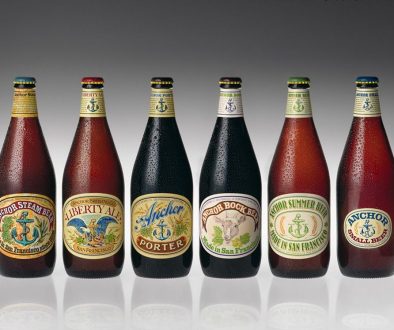Stop Messing with My IPA!!
 Danny Fullpint goes on a rant, begging breweries to stop abusing and bastardizing India Pale Ale (IPA).
Danny Fullpint goes on a rant, begging breweries to stop abusing and bastardizing India Pale Ale (IPA).
I am a huge “hop head” and an even bigger IPA fan. Nothing like sticking my beak in a glass to be blown away by a huge bouquet of pine and citrus and danky sativa. Nothing like taking the first sip and having my tongue pummeled with hop oils, resins and bitterness. I just can’t get enough IPA, and it doesn’t have to be a special time of the year for me either, I’ll take it all year ’round. Love, that’s what I have for IPA. And before we jump into my rant, regardless of what the BJCP or Brewers Association or Martyn Cornell thinks an India Pale Ale is, for me, it’s simple. Pale body, lots of bittering and aromatic hops, 5-7.5% abv.
Then Came the Black IPA
Stone celebrated their 11th Anniversary by making a double IPA with Black malt. I’m sure they weren’t the first brewer to try this, they were just the first to put it on the map. If you closed your eyes and smelled that beer fresh (Now released as Sublimely Self Righteous Ale), you would think you were smelling an IPA. Fair enough, it was a gimmick that worked.
By 2010, everybody decided to jump into the Black IPA bandwagon and breweries near and far were making a black hoppy ale with varying degrees of roast, chocolate and coffee levels, almost negating the “hoppy IPA” part altogether. Then our friends from the Pacific Northwest attempted to stear away from calling it a Black India Pale Ale, and went for Cascadian Dark Ale. While that seemed like something more appropriate, other well marketed breweries didn’t like the regional connotation Cascadian suggested, and put the squash on that. Overall, the brewer’s interpretation of this “new” style has been too all over the map for me to give it a thumbs up.
And Then The White IPA
Deschutes and Boulevard collaborated last year, making Conflux No. 2, a “White IPA.” I wasn’t able to get my hands on this beer, but the basic jist of the White IPA is to use a malted wheat bill instead of the typical pale or caramel malt IPA brewers tend to use. So sight unseen, this sounds like a hoppy wheat ale, no? This year, Deschutes introduced Chainbreaker White IPA to the market, touting smoothness with enough hops to warrant the IPA name. I have tried this beer, and between the Belgian Yeast Strain, the color, and the lack of bitterness, I would call this beer anything but an IPA. Mark my word, Deschutes won’t be the last to bust out this new marketing gimmick. Lagunitas made Little Sumpin Sumpin with a large wheat bill and a even larger does of hops, but they didn’t really slap any style labels on that beer. So as of this writing, not a fan of the gimmick.
A Hop-less IPA and a Kolsch IPA?
This week, Flying Dog and BrewDog announced a collaboration in which they would make an 0 IBU IPA. How would one do that? Without adding hops to the beer. In fact, that makes it a Gruit doesn’t it? Of all the things to bastardize the legacy of the India Pale Ale, I would say this takes the cake. We know BrewDog loves making headlines, but this is more ridiculous than stuffing a bottle up a rodents ass. Then we got wind Captain Lawrence will be making an experimental IPA using Kolsch yeast. While Kolsch-style beer is a subtle lawnmower beer with it’s own unique character, IPAs are not. So in this situation, I don’t think anyone wins, unless you want a hoppy Kolsch or a funky IPA. This doesn’t repulse me like the Flying Dog/Brewdog concept but it doesn’t make me happy or excited either.
Stop Messing with my IPA!!
The medium to large-sized craft breweries are coached by the industry to follow the trends to keep up with competition. After 3 or 4 breweries dipped into the Black IPA game, suddenly the market was flooded with “Black IPAs.” There is so much room in the market for awesome “regular old” IPAs, and many breweries have room for improvement on the highly popular style, so that’s what I’d like to see. Ask Russian River or The Alchemist if they can keep up with IPA demand. Take one of the most popular styles of beer on the market, and knock it out of the park. Just leave poor IPA alone, or come up with a better name for your product/recipe.




May 26, 2012 @ 6:30 am
I would have to agree, quit messing with IPA. CDA is an immerging style so there is always going to pureists who won’t like it, ok what ever. But a white IPA or a 0 hop IPA is like saying a sparkling porter or a stout made with no dark malts. It’s an oxymoron and it confuses people as to what they are actually drinking. Marketing gimmicks for beer have gone a bit too far, with breweries trying to stand out by changing styles so drastically that the beer they are selling isn’t even in the category they are advertising. I see nothing wrong with trying to brew something new, but don’t call it a Belgian trappest barrel aged blonde ale, when its really just an American light beer just because you think people will like better if it has a fancy name.
March 31, 2012 @ 1:16 pm
Don’t forget that the American IPA that you love is a hop-rape of the English version in the first place. It would never have existed with this attitude.
March 30, 2012 @ 9:16 am
Actually the kolsch yeast is fairly neutral and works well for IPA’s as it attenuates up to 77% yielding a dry finish which is what you want from an IPA. You definitely don’t want an under-attenuated IPA.
BJCP Guidelines for American IPA:
14B. American IPA
Aroma: A prominent to intense hop aroma with a citrusy, floral, perfume-like, resinous, piney, and/or fruity character derived from American hops. Many versions are dry hopped and can have an additional grassy aroma, although this is not required. Some clean malty sweetness may be found in the background, but should be at a lower level than in English examples. Fruitiness, either from esters or hops, may also be detected in some versions, although a neutral fermentation character is also acceptable. Some alcohol may be noted.
Appearance: Color ranges from medium gold to medium reddish copper; some versions can have an orange-ish tint. Should be clear, although unfiltered dry-hopped versions may be a bit hazy. Good head stand with white to off-white color should persist.
Flavor: Hop flavor is medium to high, and should reflect an American hop character with citrusy, floral, resinous, piney or fruity aspects. Medium-high to very high hop bitterness, although the malt backbone will support the strong hop character and provide the best balance. Malt flavor should be low to medium, and is generally clean and malty sweet although some caramel or toasty flavors are acceptable at low levels. No diacetyl. Low fruitiness is acceptable but not required. The bitterness may linger into the aftertaste but should not be harsh. Medium-dry to dry finish. Some clean alcohol flavor can be noted in stronger versions. Oak is inappropriate in this style. May be slightly sulfury, but most examples do not exhibit this character.
Mouthfeel: Smooth, medium-light to medium-bodied mouthfeel without hop-derived astringency, although moderate to medium-high carbonation can combine to render an overall dry sensation in the presence of malt sweetness. Some smooth alcohol warming can and should be sensed in stronger (but not all) versions. Body is generally less than in English counterparts.
Overall Impression: A decidedly hoppy and bitter, moderately strong American pale ale.
History: An American version of the historical English style, brewed using American ingredients and attitude.
Ingredients: Pale ale malt (well-modified and suitable for single-temperature infusion mashing); American hops; American yeast that can give a clean or slightly fruity profile. Generally all-malt, but mashed at lower temperatures for high attenuation. Water character varies from soft to moderately sulfate. Versions with a noticeable Rye character (“RyePA”) should be entered in the Specialty category.
Vital Statistics: OG: 1.056 – 1.075
IBUs: 40 – 70 FG: 1.010 – 1.018
SRM: 6 – 15 ABV: 5.5 – 7.5%
Commercial Examples: Bell’s Two-Hearted Ale, AleSmith IPA, Russian River Blind Pig IPA, Stone IPA, Three Floyds Alpha King, Great Divide Titan IPA, Bear Republic Racer 5 IPA, Victory Hop Devil, Sierra Nevada Celebration Ale, Anderson Valley Hop Ottin’, Dogfish Head 60 Minute IPA, Founder’s Centennial IPA, Anchor Liberty Ale, Harpoon IPA, Avery IPA
March 29, 2012 @ 8:54 am
I’m all for beer experimentation and all, but I think there is a fine line as to what you can call a certain style. In my book, to call something with 0 IBU an IPA is blasphemy! Whether the beer is good or not, it doesn’t change the fact that it is being marketed as a style that is characteristically known for its hops; however much or little is used.
March 28, 2012 @ 3:37 pm
There are 2,749 IPA’s listed on BA.
Don’t buy what doesn’t interest you and you’ll be ok, I promise.
March 28, 2012 @ 1:44 pm
From our Facebook page — So I’m not saying don’t be creative, quite the opposite. I’m saying don’t be lazy for the sake of selling beer. IPA is the biggest selling style/brand for breweries. Look at Ranger IPA by New Belgium or SN Torpedo. Now you take a beer that doesn’t have the characteristics of those two beers, but slap the term IPA on it, you are now doing two things. You are upsetting OG’s like me who love IPA, and you are confusing the newbs. Someone might order Chainbreaker IPA and say, wow, that’s smooth, and very drinkable. Then they go to another bar, and say, based on my first go round with an IPA, I love IPAs. They order a West Coast IPA by Green Flash, and say, I hate IPAs now, that’s way too hoppy. I strongly feel the tern IPA is being misused, not that I don’t want breweries to try new recipes and such.
March 28, 2012 @ 1:40 pm
My first thought about your rant is this: OK, I get it, but did the beer taste good? The ultimate sin is a brewery going for some neat-sounding idea only to have the beer suck. If the beer tastes good though, for me, all bets are off. I don’t give a shit what it’s called; I’ll be drinking it again. I leave quibbling about styles to BJCP discussions.
March 28, 2012 @ 1:20 pm
So if they don’t call it an IPA then every one is happy? This seems like a pretty weak argument. While I can agree that there are certain words “double (IPA, red, even stout now) Imperial (Stout, Wit, Red, Pilsner etc.) I’m not all in a bunch about it. If you don’t like it just don’t drink it. Or!, relax it’s just beer.
March 28, 2012 @ 1:00 pm
Yeah – I’m with you, Dan. Even though I must admit that I do really like me a little Little Sumpin’ Sumpin’ now and again, for the most part I just stick with my beloved Bell’s Two Hearted Ale, Stone Ruination, Heavy Seas Loose Cannon Hop3, and early every year some good old Bell’s Hopslam. (Never had Pliny – can’t get it here in Fla.) But I agree that all breweries should focus on making at least one outstanding, normal, sticky IPA.
March 28, 2012 @ 11:25 am
Love it, yes, no black or white IPA’s. I don’t even drink the IPA’s with Belgian yeast as i am partial to what I like..What the heck is up with a hop-less IPA, just sounds like a gimmick..
March 28, 2012 @ 10:49 am
“It’s not spaghetti if it’s made with fettuccine!”
I’m with Eric, although I’ll add that plenty of those beers don’t sound great to me. The ultimate judgement should be left for our senses, and we’d do well to remember that we use styles as a talking point and in competition – not to guide the brewer.
March 28, 2012 @ 10:21 am
Well put! 0 IBU is not what I drink an IPA for and I like Kolsch just the way it is.
March 28, 2012 @ 10:13 am
Relax. It’s just beer.